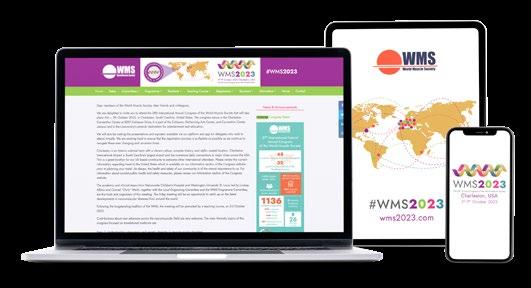




Dear members of the World Muscle Society, friends and colleagues, Welcome to the 28th annual congress of the World Muscle Society in Charleston, South Carolina.
It’s great to be back together again. It’s our second consecutive trip to continental North America after our Halifax Congress last year. Our next two Congresses will be in Europe (Prague in 2024 and Vienna in 2025) and then we’ll make only our second ever visit to Japan when we host the Hiroshima Congress in 2026. Look out for the announcement during this Congress of where we will go in 2027.
Whether you’re attending in person or joining virtually, you can expect all the usual features of a great WMS Congress: lively discussions at the poster boards, informal networking at coffee breaks, and four days of the latest scientific and clinical developments in the field of neuromuscular disorders.
This year, we have also added a suite of new elements: for the first time, we are hosting a ‘Career Development Workshop’, and a session for ‘Interesting Case Discussions’ as well as a series of live, informal Myology Café sessions. We have arranged these new activities to promote inclusion, particularly for early career researchers and clinicians and I hope many of you will take part.
On behalf of the Executive Board, I would like to thank our sponsors and exhibitors for their support in enabling this Congress to go ahead. I would also like to extend particular thanks to our Local Organising Committee, Programme Committee and Management Team for their hard work behind the scenes.
I very much look forward to speaking to as many of you as possible over the course of the Congress. I urge you all to take this opportunity to build new connections. Say hello to the people whose work you admire or whose career interests you. Our Society is at its strongest when we make our global work local.
With very best wishes,
Volker Straub President
wms2023.com
Dear delegate,
Welcome to Charleston! It is our great pleasure to host you here in the USA.
Our 28th annual Congress is set to be the biggest yet. Not only are we in a venue that enables us to grow our attendance, but we also have a packed programme full of engaging and enlightening sessions.
You can find the full programme in our app and your joining email will include details of the sessions you have selected.
This year we will cover three core topics:

• Topic 1 - Understanding phenotypic and genetic diversity in neuromuscular disorders

• Topic 2 - Pathobiology of neuromuscular expansion disorders
• Topic 3 - The effect of lifestyle, exercise and nutrition on neuromuscular pathology and outcomes
Each day a plenary session will be dedicated to the selected topics. Speakers will summarise the state of the field on the selected topics, covering clinical, molecular and other aspects.
As well as our plenary sessions, we will have opportunities to explore the latest science in any number of areas. Our poster presentations always lead to fascinating discussions and this year promises to be just as lively as any other. Our Prize Giving ceremony on Saturday morning also celebrates innovation and excellence in our field. We’ll look forward to seeing you there.
Our thanks to the Executive Board for selecting Charleson, South Carolina as the host city for the 28th Annual Congress, to our fellow members of the Local Organising Committee and Programme Committee for their tireless efforts to ensure a successful event and to everyone involved in organising this year’s meeting. It has very much been a team effort!
With best wishes




3rd-7th October 2023
wms2023.com


Kindly supported by



























wms2023.com














3rd-7th October 2023

wms2023.com
16:3017:30
WMS Industry Symposium 1
Bulbar function in spinal muscular atrophy: unmet needs and experiences from clinical practice
WMS Industry Symposium 2
Becker Muscular Dystrophy Natural History and ARCH, an Open Label Study in BMD: Putting the data in Context
07:3008:30
WMS Industry Symposium 3 Duchenne Muscular Dystrophy: What Are the Measures That Matter?
WMS Industry Symposium 4
Developments in the Management of Late Onset Pompe Disease



19:1520:15
WMS Industry Symposium 5 Dystrophin in Muscular Dystrophy: Evolving our Understanding
WMS Industry Symposium 6
Optimizing Care: Real World Experience in Patients with Late-Onset Pompe Disease


08:0009:00
WMS Industry Symposium 7
Neurodevelopment and Degeneration in SMA: Focus on Upper-Limb Function in Children

WMS Industry Symposium 8
Connecting the dots: all-around care and evidence in Duchenne muscular dystrophy
Please see: https://www.wms2023.com/page/industry-symposia for other information. All times are in local Charleston, South Carolina, USA time.



Amicus is committed to improving the lives of patients and families a ected by rare and orphan diseases.



Come along to our in-person Myology Café Exhibitor Hall B (usually virtual) and find out about how to get involved:
Wednesday 4th October 2023 10:45-11:15 Social Media Committee
Wednesday 4th October 2023 13:45-14:15 New Members’ Event

Thursday 5th October 2023 11:00-11:30 Guidelines Committee
Friday 6th October 2023 10:00-10:30

Myology Developments Across the World and Education Committees



Join us at our satellite symposium* at WMS 2023 to exchange insights on bulbar function in spinal muscular atrophy (SMA) with our expert panel


Tuesday, 3 October 2023 | 16:30–17:30 EST



Performing Arts Centre (PAC)
We look forward to seeing you there!
You are also invited to check out our data presentations at WMS!
WEDNESDAY, OCTOBER 4, 2023 | 7:30–8:30 AM EST
WMS Industry Symposium 3 - Pfizer
PAC Theatre, Charleston, South Carolina
Overview
With the arrival of new treatments in Duchenne muscular dystrophy (DMD), we have witnessed a change in the disease trajectory. But what does this mean for the patient journey, and how does it impact the way we monitor disease progression and measure motor function?


Join us for a one-hour symposium during which our expert panel, Prof Laurent Servais and Dr Tina Duong, will deep dive into functional assessment tools used in DMD, focusing on the North Star Ambulatory Assessment and how it correlates with the patients’ experience.
Faculty
Laurent Servais, MD, PhD

Professor of Paediatric
Neuromuscular Diseases
MDUK Oxford Neuromuscular Center
Department of Paediatrics
University of Oxford
Tina Duong, PT, PhD

Director of Clinical Outcomes
Research & Development
Division of Neuromuscular Medicine
Stanford University
This symposium is funded by Pfizer Inc EM-USA-DMD-0029 WMS Industry Symposium
Agenda

Introduction
Considerations in Measuring DMD Function Today
Motor Function in DMD: Focus on the North Star Ambulatory Assessment
Q&A and Summary












Thursday, October 5, 2023
8:00 AM to 9:00 AM EDT | PAC Theatre



A light breakfast will be provided
Accumulated clinical experience is challenging us to rethink the relationship between motor pool composition and motor function. Please join our faculty as they critically examine the clinical data in nusinersen-treated non-ambulatory children, with a particular focus on assessing change in upper-limb function.




“I became an artist because the most important form of freedom is to realize yourself and to be who you are. I love creating magic, putting something together that is completely unusual and so unexpected that it takes people’s breath away. Something that is ahead of its time. Five steps ahead of what people think.”
Phil L. Herold is an internationally recognized artist who describes himself as a “cyberspace expressionist of the 21st century”. Born in Munich in April 1980, and diagnosed with SMA type 2 in early childhood, today Phil designs his large-format works of art on a PC, using a small joystick on his wheelchair. Thus, through only the minimal movement that he is left with, he continues to create, inspire, delight and challenge us.


WEDNESDAY, OCTOBER 4, 2023 | 7:30–8:30 AM EST
WMS Industry Symposium 3 - Pfizer
PAC Theatre, Charleston, South Carolina
With the arrival of new treatments in Duchenne muscular dystrophy (DMD), we have witnessed a change in the disease trajectory. But what does this mean for the patient journey, and how does it impact the way we monitor disease progression and measure motor function?

Join us for a one-hour symposium during which our expert panel, Prof Laurent Servais and Dr Tina Duong, will deep dive into functional assessment tools used in DMD, focusing on the North Star Ambulatory Assessment and how it correlates with the patients’ experience.
Overview This symposium is funded by Pfizer Inc EM-USA-DMD-0024
Learning Objectives
• Understand the typical patient journey in DMD and the disease trajectory
• Discuss the importance of functional assessment tools in DMD and what clinicians and patients can and should expect from these
• Understand the strengths and limitations of different assessment tools, such as the North Star Ambulatory Assessment (NSAA) rating scale
• Discuss how functional assessment tools can be best utilized in clinical practice and in research
Duchenne Muscular Dystrophy: What Are the Measures That Matter?

Laurent Servais, MD, PhD

Professor of Paediatric
Neuromuscular Diseases
MDUK Oxford Neuromuscular Center
Department of Paediatrics
University of Oxford
Tina Duong, PT, PhD

Director of Clinical Outcomes
Research & Development
Division of Neuromuscular Medicine
Stanford University
Agenda
Introduction
Considerations in Measuring DMD Function Today
Motor Function in DMD: Focus on the North Star Ambulatory Assessment
Q&A and Summary
This symposium is funded by Pfizer Inc EM-USA-DMD-0024
In a clinical trial of 196 boys aged 5 to 15 with Duchenne muscular dystrophy, the effectiveness and safety of EMFLAZA was compared with placebo (sugar pills) and prednisone. EMFLAZA improved muscle strength at 12 weeks compared with placebo (0.15 change in strength score vs -0.10 change in strength score)


*These findings were not considered statistically significant. This means that because the two groups studied were not large enough, the results could have occurred by chance.
Real-world outcomes of long-term prednisone and deflazacort use in patients with Duchenne muscular dystrophy: experience at a single, large care center.
Objective: To assess outcomes among patients with DMD receiving deflazacort or prednisone in real-world practice.
Over 11.9 years, 17.9% of patients developed scoliosis taking prednisone vs 7.9% taking deflazacort.
Methods: Clinical data for 435 boys with DMD from Cincinnati Children’s Hospital Medical Center were studied retrospectively using time-to-event and regression analyses.



Results: Median ages at loss of ambulation were 15.6 and 13.5 years among deflazacort- and prednisone-initiated patients, respectively. Deflazacort was also associated with a lower risk of scoliosis, improved ambulatory function, greater % lean body mass, shorter stature, and lower weight, after adjusting for age and steroid duration. No differences were observed in whole body bone mineral density or left ventricular ejection fraction.
Marden JR, Freimark J, Yao Z, Signorovitch J, Tian C, Wong BL. Real-world outcomes of long-term prednisone and deflazacort use in patients with Duchenne muscular dystrophy: experience at a single, large care center. J Comp Eff Res. 2020;9(3):177-189. doi:10.2217/ cer-2019-0170.
*Forced vital capacity is a type of test that measures the amount of air your son can inhale and exhale.

What is EMFLAZA® (deflazacort) used for?
Emflaza is a prescription medicine used to treat Duchenne muscular dystrophy (DMD) in patients 2 years of age and older.
When should I not take EMFLAZA?
Do not use if you have had hypersensitivity, including allergic reactions, to deflazacort or any of the inactive ingredients.
What warnings should I know about EMFLAZA?
• EMFLAZA can cause changes in endocrine function. Do not stop taking EMFLAZA, or change the amount you are taking, without first checking with your healthcare provider, as there may be a need for gradual dose reduction to decrease the risk of adrenal insufficiency and steroid “withdrawal syndrome”. Acute adrenal insufficiency can occur if corticosteroids are withdrawn abruptly, and can be fatal. A steroid “withdrawal syndrome,” seemingly unrelated to adrenocortical insufficiency, may also occur following abrupt discontinuance of corticosteroids. For patients already taking corticosteroids during times of stress, the dosage may need to be increased.
• There is an increased risk of infection when taking EMFLAZA. Tell the healthcare provider if the patient has had recent or ongoing infections or if they have recently received a vaccine. Medical advice should be sought immediately if the patient develops fever or other signs of infection. Patients and/or caregivers should be made aware that some infections can potentially be severe and fatal. Warn patients who are on corticosteroids to avoid exposure to chickenpox or measles and to alert their healthcare provider immediately if they are exposed.
• EMFLAZA can cause an increase in blood pressure and water retention. If this occurs, dietary salt restriction and potassium supplementation may be needed.
• There is an increased risk of developing a hole in the stomach or intestines in patients with certain stomach or intestine disorders when taking corticosteroids like EMFLAZA.
• EMFLAZA can cause severe behavioral and mood changes. Seek medical attention from the health care provider if any behavioral or mood changes develop.
• There is a risk of osteoporosis with prolonged use of EMFLAZA, which can lead to vertebral and long bone fractures.
• EMFLAZA may cause cataracts or glaucoma and a health care provider should monitor for these conditions if corticosteroid therapy is continued for more than 6 weeks.
• Immunizations should be up-to-date according to immunization guidelines prior to starting therapy with EMFLAZA. Live-attenuated or live vaccines should be administered at least 4 to 6 weeks prior to starting EMFLAZA. Live-attenuated or live vaccines should not be used in patients taking EMFLAZA.
• EMFLAZA can cause serious skin rashes. Seek medical attention at the first sign of a rash.
• Rare instances of anaphylaxis have occurred in patients receiving corticosteroid therapy, including EMFLAZA.
Tell the health care provider about all medical conditions, including if the patient:
• is pregnant or planning to become pregnant. EMFLAZA® (deflazacort) can harm your unborn baby.
• is breastfeeding or planning to breastfeed. EMFLAZA may appear in breastmilk and could affect a nursing child.
Certain medications can cause an interaction with EMFLAZA. Tell your healthcare provider of all the medicines you are taking, including over-the-counter medicines (such as insulin, aspirin or other NSAIDS), dietary supplements, and herbal products. Alternate treatment, dosage adjustment, and/or special test(s) may be needed during the treatment.
The most common side effects of EMFLAZA include facial puffiness or Cushingoid appearance, weight increased, increased appetite, upper respiratory tract infection, cough, frequent daytime urination, unwanted hair growth, central obesity, and colds. These are not all of the possible side effects of EMFLAZA. Call your doctor for medical advice about side effects.
To report an adverse event, please call 1-866-562-4620 or email at usmedinfo@ptcbio.com. You may also report side effects to FDA at 1-800-FDA-1088 or at www.fda.gov/medwatch.
Emflaza® is a registered trademark of PTC Therapeutics, Inc. © 2022 PTC Therapeutics, Inc. All Rights Reserved. US-EMF-0292 11/22


Avidity Biosciences aims to profoundly improve people’s lives by revolutionizing the delivery of RNA therapeutics. Beginning with our muscle disease franchise, our Antibody Oligonucleotide Conjugates (AOC™) platform is designed to more effectively target the root cause of disease. Our pipeline includes three lead clinical-stage programs for three distinct rare diseases – myotonic dystrophy type 1 (DM1), Duchenne muscular dystrophy (DMD), and facioscapulohumeral muscular dystrophy (FSHD) – and the potential to expand into additional tissues and cell types, including cardiac tissue and immune cells, through a combination of partnerships and internal discovery that leverages our team’s unparalleled expertise in development of RNA and rare disease therapies.

Avidity’s proprietary AOC platform combines the specificity of monoclonal antibodies (mAbs) with the precision of oligonucleotide therapies to target a range of different cells and tissues beyond the liver, which up until now have been inaccessible with existing RNA-based therapeutics. In December 2022, we demonstrated the first-ever successful targeted delivery of RNA into muscle, a revolutionary advancement for the field of RNA therapeutics. These data were reported as part of a preliminary assessment of AOC 1001 from a Phase 1/2 clinical trial in DM1. The effective targeted delivery of siRNA into muscle further reinforces the broad and disruptive potential of Avidity’s proprietary AOC platform and expands the ability to address targets and diseases previously unreachable with existing RNA therapies. We also have research and development efforts focused on targeting cardiac tissue, immune cells and other cell types.
The broad flexibility of our AOC platform allows us to deploy various types of oligonucleotides, including small interfering RNAs (siRNAs) and phosphorodiamidate morpholino oligomers (PMOs), each of which can be engineered to modify RNA function in different ways to modulate specific disease processes. continued on reverse
“It is very exciting to think about the future of Avidity and, most importantly, the opportunity to make a positive difference for people with serious diseases who could benefit from AOCs and RNA therapies.”
& CEO
Designed to combine the specificity of mAbs with the precision of oligonucleotide therapiesMONOCLONAL ANTIBODIES OLIGONUCLEOTIDE THERAPIES ANTIBODY OLIGONUCLEOTIDE CONJUGATE (AOC)
3rd-7th
AOC 1001*
Myotonic Dystrophy Type 1 (DM1) DMPK
AOC 1044
Duchenne Muscular Dystrophy (DMD)


AOC 1020
Facioscapulohumeral Muscular Dystrophy (FSHD)
Additional DMD Programs
Rare Skeletal Muscle Program
Rare Cardiac Program
Exon 44
DUX4
Exon 45 & Undisclosed
Undisclosed
Undisclosed

OUR THREE LEAD CLINICAL-STAGE PROGRAMS
Avidity’s most advanced program is AOC 1001 for the treatment of adults with DM1, which is being assessed in the Phase 1/2 MARINA™ and MARINA-OLE™ clinical trials. In April 2023, Avidity announced positive topline AOC 1001 data from the Phase 1/2 MARINA trial demonstrating functional improvement in multiple clinical outcome measures, disease modification and a favorable safety and tolerability profile in adults with DM1. The disease impacts more than 40,000 people in the U.S. and currently has no approved therapies.
AOC 1044 is being assessed in the Phase 1/2 EXPLORE44™ clinical trial in healthy volunteers and people with DMD amenable to exon 44 skipping (DMD44). DMD is characterized by progressive muscle damage and weakness and is caused by lack of functional dystrophin protein. People living with DMD often require special aid and assistance throughout their lives and have significantly shortened life expectancy. DMD is a monogenic, X-linked, recessive disease that primarily affects males, with 1 in 3,500 to 5,000 boys born worldwide having Duchenne. Currently there are no approved therapies to treat the underlying mechanism of disease for people living with DMD44.
AOC 1020 is currently being assessed in the Phase 1/2 FORTITUDE™ clinical trial in adults living with FSHD, a rare, progressive and variable hereditary muscle-weakening condition marked by progressive loss of function, significant pain, fatigue, and disability. The disease is caused by the abnormal expression of the DUX4 gene and affects approximately 16,000-38,000 people in the U.S. There are currently no approved therapies to treat the underlying cause of FSHD.
We are a highly focused, research-driven biopharmaceutical company working in rare diseases. Our current goal is to optimize the potential of exon-skipping therapy in treating Duchenne muscular dystrophy (DMD).


Please Join our Poster Presentation
P52: Experiences of parents/caregivers of children in the ASPIRO X-Linked Myotubular Myopathy (XLMTM) gene therapy clinical trial: A qualitative study
Session: Clinical trial highlights
October 4, 2023, 14:30-15:30
Presenter: Clara Juando-Pratz
Clinical Research Specialist, Li Ka Shing Knowledge Institute (St. Michael’s Hospital, Toronto) Assistant Professor, Dalla Lana School of Health University of Toronto
Did you know?
X-linked Myotubular Myopathy (XLMTM) is a rare, life-threatening monogenic congenital myopathy with an estimated incidence of 1 in 40,000-50,000 newborn males.1,2

To learn more: Visit our website AstellasGeneTherapies.com
GUARANTEE
THE SAFETY AND EFFICACY OF THE AGENTS UNDER INVESTIGATION HAVE NOT BEEN ESTABLISHED. THERE IS NO
THAT THE AGENTS WILL RECEIVE REGULATORY APPROVAL OR BECOME COMMERCIALLY AVAILABLE FOR USES BEING INVESTIGATED. THESE AGENTS ARE NOT AUTHORIZED FOR SALE IN ANY JURISDICTION.














































G71.031
G71.032
G71.033
G71.0340
G71.0341
G71.0342
G71.0349
G71.035
Autosomal dominant limb-girdle muscular dystrophy
Autosomal recessive limb-girdle muscular dystrophy due to calpain-3 dysfunction (calpainopathy)
Limb-girdle muscular dystrophy due to dysferlin dysfunction (dysferlinopathy)
Limb-girdle muscular dystrophy due to sarcoglycan dysfunction, unspecified (sarcoglycanopathy)
Limb-girdle muscular dystrophy due to alpha sarcoglycan dysfunction (alpha-sarcoglycanopathy)
Limb-girdle muscular dystrophy due to beta sarcoglycan dysfunction (beta-sarcoglycanopathy)
Limb-girdle muscular dystrophy due to other sarcoglycan dysfunction
Limb-girdle muscular dystrophy due to anoctamin-5 dysfunction (anoctaminopathy)
G71.038 Other limb-girdle muscular dystrophy
G71.039 Limb-girdle muscular dystrophy, unspecified
LGMD1/D
LGMD2A/R1
LGMD2B/R2
LGMD2D/R3
LGMD2E/R4
LGMD2C/R5*
LGMD2F/R6*
LGMD2L/R12


3rd-7th October 2023 wms2023.com

L a mb e r t- E a t o n my astheni c s y nd r om e ( LEMS ) an d my asthenia g ra v is ( MG ) sha r e s e v e ral hall m a r k si g ns and s ymp t om s , in c l u din g m u sc l e we akn es s and oc ul o bulbar in vo lv eme n t 1, 2
On e way t o dif fe r e nti ate these two immun e -m e di ated neu r omu s cul a r diso r d er s i s t o lo o k f o r thes e s pe cific signs and s y mptom s 1, 2 :
LEMS MG
Symmetrical muscle weakness
Typically asymmetrical muscle weakness
Caudal-to-cranial pattern of spread
Late-onset and mild oculobulbar involvement
Cranial-to-caudal pattern of spread
Early and prominent oculobulbar involvement
Absent or diminished tendon reflexes
Preserved tendon reflexes
Autonomic dysfunction
Transient improvement of muscle strength with exercise, with fatigue that follows
Antibodies to voltage-gated calcium channels (VGCC) are usually found
No autonomic dysfunction
Muscle weakness worsens with exercise
Antibodies to AChR or MuSK are usually found



Advancing diagnosis, care & treatment for those living with neuromuscular diseases


https://treat-nmd.org/
TREAT-NMD is a global network advancing diagnosis, care and treatment for people with rare neuromuscular diseases. We connect patients, clinicians, researchers and industry to support drug development and access to life changing treatments.


To
